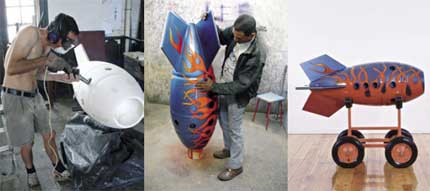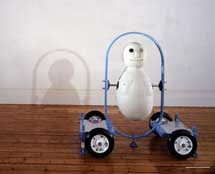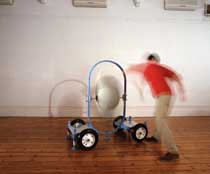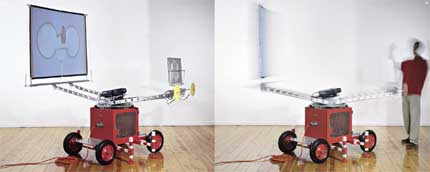Johann van der Schijff’s meticulously finished machines toy play with the notion of military and manufacturing industry’s power.
 Bomb
Bomb
Examining power relationships in society, the Power Play pieces take as point of departure a line in Lev Manovich’s The Language of New Media: “as the pioneer of interactive filmmaking Graham Weinbren argues, in relation to interactive media, making a choice involves a moral responsibility.”

 Slaansak/Punch Bag
Slaansak/Punch Bag
Van der Schijff’s aim is for the viewer to be forced into a position of choice in their engagement with the work (“shall I hit the blow-up doll / punch bag or not?”). The workmanship and finishes (facilitated by computer-aided design and manufacturing techniques) are meticulous, and are aimed to emulate and appeal in the same way as objects in designer-lifestyle shops.
 Lazy Susan
Lazy Susan
Lazy Susan operates as a scanning device: as the viewer enters the field covered by the rotating top section, the animation projected onto the screen tracks the viewer with the top section of the interactive sculpture follows the viewer. Instead of being merely looked at, the artwork “looks back” at the visitor for a few seconds before it continues to scan for new targets.
The Pretoria-born artist’s iconography was informed by the bright colours of township sculptures, Zulu beading and Xhosa fabrics. In addition to the obvious connection to wooden children’s toys, a direct lineage can be traced to the tractors, lorries and aeroplanes made from discarded Coke and Nugget tins combined with blue wire on my uncle’s farm in Ventersdorp, and the bright enamel paint applied by hand to my sculptures, writes the artist.
Check Johann van der Schijff’s first solo exhibition, Power Play, at Bell-Roberts Contemporary Art Gallery, Cape Town, until 20 May 2006. More pictures in the catalogue of the exhibition.
See also: Fabrice Gygi’s aesthetics of authority.
Thanks Rob!
